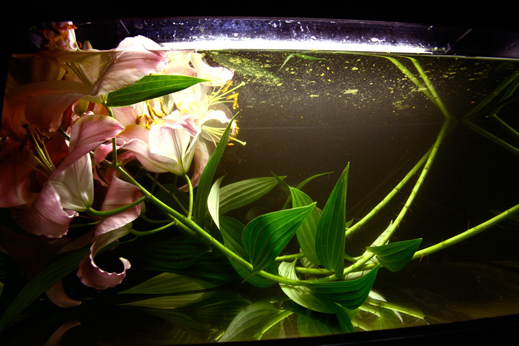 |
| Angry Lily (from "Canary" series), C-type print, 2007 |
|
|
"Canary" is a carefully edited slide sequence of still photographs, projected onto a wall and accompanied by an atmospheric soundtrack. The photographs were taken by Lieko Shiga during residencies in Brisbane and Sendai in 2006, and were made into a projected work for exhibitions in Australia and Sendai in late 2006.
The work leaves one feeling haunted. Although it can be understood within the lineage of an important sub-genre of photographic history often called spiritualist or spirit photography, Shiga's work moves beyond this into realms of what the French philosopher Georges Bataille referred to as "uppermost extremity of non-meaning." Many of the images in "Canary" show human bodies or objects floating free of gravity, or bodies in what look like scenes of electrified telepathic communication, surrounded by bright lights, fire or over-exposed glares. These are images which tap into our databases for occult imagery, culled from horror films like The Blair Witch Project or from historical depictions by artists like William Blake or Francisco Goya. They provide certain atmospheres within which we begin to feel the affects of something else, something cursed.
However, "Canary" presents a sequence which moves out from such paranormal readings. The collective effect is something like a sense of loss, and it is here that I am reminded of Bataille's thinking on sacrifice. For Bataille, sacrifice does not begin anything. Rather, it ends and ruptures, leaving absolute loss in its wake. Reading Shiga's own comments on photography, these thoughts reverberated: "You can talk about photographs in terms of 'shooting': to 'shoot' with a camera like you would shoot with a gun. However, for me, taking photos is not like shooting, but the reverse: it's like being shot. I am shot, and the entire timeline of my existence is resurrected in the photograph. So, I think photography is the revival of eternal time and of eternal life..." For Bataille, sacrifice was one way in which human beings could open to the sacred, to the realm of the mythological. This may be mapped onto what Shiga calls the revival of eternal time, of eternal life. And it is significant that she speaks about "being shot" when taking photographs, as if every captured frame was also a momentary sacrifice, a giving of oneself to the image.
The cumulative effect of watching "Canary" thus seemed to gravitate towards this extreme zone of sacrifice, or non-meaning, which may also return us to a remembering of mythological themes -- of time, death, light, darkness and eternity. What I found particularly interesting was the editing of still photographs into a projected sequence that linked the images together through time. In this way, and quite differently to cinema, the work finds a liminal zone in between the still sharpness of the single frame and the rapid succession of frames which characterize film. This method of presenting photographs is not new, and one can cite the important work of Nan Goldin (The Ballad of Sexual Dependency, 1986) or even Robert Smithson (Hotel Palenque, 1969-72). However, Shiga reformulates the formal and psychological effects of this mode to create something highly original and at the same time, deeply archaic. Shiga's inclusion in a festival devoted to exploring the horizons of mediated images today was highly appropriate. Rather than a formal or technical investigation of new media, Shiga's practice literally seems to excavate our relationship with images, stripping them of their familiar surfaces to reveal the always latent psychological and mythical dimensions which images still hold.
|